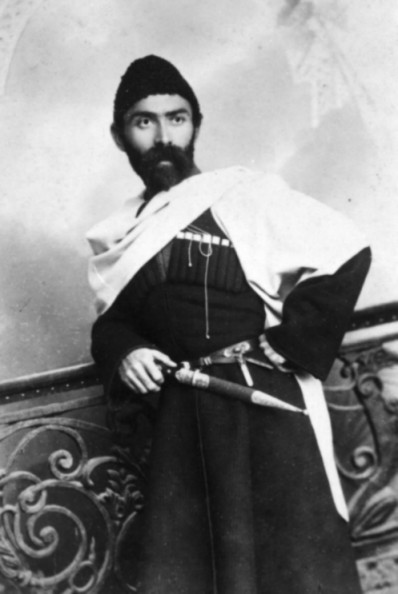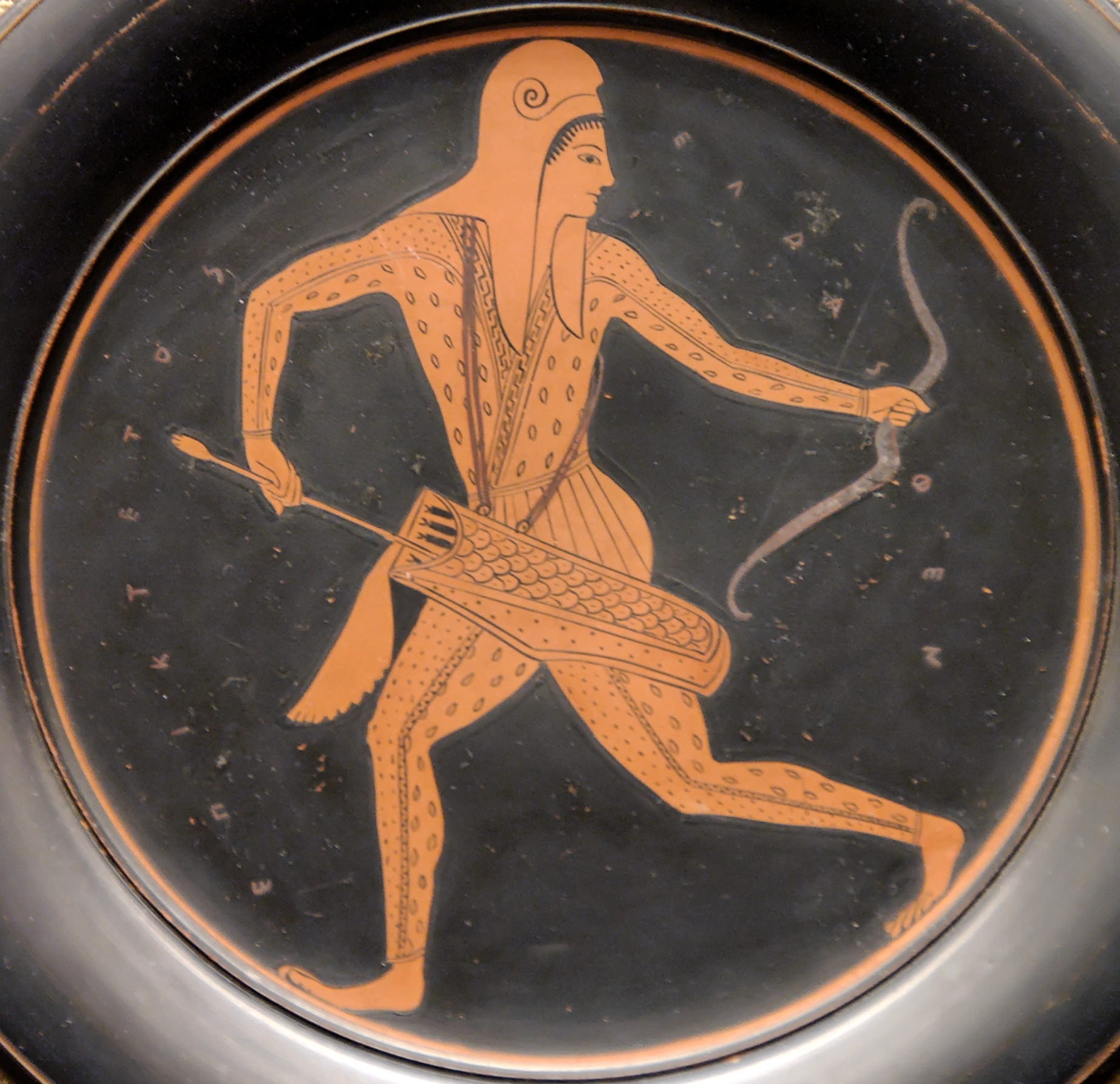bashlyk on:
[Wikipedia]
[Google]
[Amazon]
 A bashlyk, also spelled bashlik, is a traditional Turkic, Caucasian,
A bashlyk, also spelled bashlik, is a traditional Turkic, Caucasian,  A variation of bashlyk is the kalpak (''qalpaq''), a cone-shaped headdress without lappets, mostly made of leather, felt or wool, and the malahai, also known as the ''tymak'', a curved cone-shaped headdress, either with or without lappets, mostly made of leather, and occasionally with a
A variation of bashlyk is the kalpak (''qalpaq''), a cone-shaped headdress without lappets, mostly made of leather, felt or wool, and the malahai, also known as the ''tymak'', a curved cone-shaped headdress, either with or without lappets, mostly made of leather, and occasionally with a
 In modern times, bashlyks became fashionable in Russia in 1830-1840, after the
In modern times, bashlyks became fashionable in Russia in 1830-1840, after the
File:Казаки оренбургского войска.jpg, Orenburg Cossacks wearing bashlyks and cloaks (on the left), 1839
File:Заштатный.jpg, A sketch of an old man by
 A bashlyk, also spelled bashlik, is a traditional Turkic, Caucasian,
A bashlyk, also spelled bashlik, is a traditional Turkic, Caucasian, Iranian
Iranian () may refer to:
* Something of, from, or related to Iran
** Iranian diaspora, Iranians living outside Iran
** Iranian architecture, architecture of Iran and parts of the rest of West Asia
** Iranian cuisine, cooking traditions and practic ...
, and Cossack
The Cossacks are a predominantly East Slavic Eastern Christian people originating in the Pontic–Caspian steppe of eastern Ukraine and southern Russia. Cossacks played an important role in defending the southern borders of Ukraine and Rus ...
cone-shaped hooded headdress
Headgear, headwear, or headdress is any element of clothing which is worn on one's head, including hats, helmets, turbans and many other types. Headgear is worn for many purposes, including protection against the elements, decoration, or fo ...
, usually of leather
Leather is a strong, flexible and durable material obtained from the tanning (leather), tanning, or chemical treatment, of animal skins and hides to prevent decay. The most common leathers come from cattle, sheep, goats, equine animals, buffal ...
, felt
Felt is a textile that is produced by matting, condensing, and pressing fibers together. Felt can be made of natural fibers such as wool or animal fur, or from synthetic fibers such as petroleum-based acrylic fiber, acrylic or acrylonitrile or ...
or wool
Wool is the textile fiber obtained from sheep and other mammals, especially goats, rabbits, and camelids. The term may also refer to inorganic materials, such as mineral wool and glass wool, that have some properties similar to animal w ...
, featuring a round topped bonnet with lappets for wrapping around the neck. Local versions determine the trim, which may consist of decorative cords, embroidery, jewelry, metallized strings, fur balls or tassels. Among dozens of versions are winter bashlyks worn atop regular headdress, cotton bashlyks, homeknitted bashlyks, silk bashlyks, scarf bashlyks, down bashlyks, dress bashlyks, jumpsuit-type bashlyks, etc. Bashlyks are used as traditional folk garment, and as uniform headdress.
 A variation of bashlyk is the kalpak (''qalpaq''), a cone-shaped headdress without lappets, mostly made of leather, felt or wool, and the malahai, also known as the ''tymak'', a curved cone-shaped headdress, either with or without lappets, mostly made of leather, and occasionally with a
A variation of bashlyk is the kalpak (''qalpaq''), a cone-shaped headdress without lappets, mostly made of leather, felt or wool, and the malahai, also known as the ''tymak'', a curved cone-shaped headdress, either with or without lappets, mostly made of leather, and occasionally with a fur
A fur is a soft, thick growth of hair that covers the skin of almost all mammals. It consists of a combination of oily guard hair on top and thick underfur beneath. The guard hair keeps moisture from reaching the skin; the underfur acts as an ...
-wrapping, originally worn by most inhabitants of the Idel-Ural, but nowadays mostly reduced to the Bashkirs
The Bashkirs ( , ) or Bashkorts (, ; , ) are a Turkic peoples, Turkic ethnic group indigenous to Russia. They are concentrated in Bashkortostan, a Republics of Russia, republic of the Russian Federation and in the broader historical region of B ...
. It also went on to inspire the budenovka in the USSR
The Union of Soviet Socialist Republics. (USSR), commonly known as the Soviet Union, was a List of former transcontinental countries#Since 1700, transcontinental country that spanned much of Eurasia from 1922 until Dissolution of the Soviet ...
.
History
The origins of this conical headgear can possibly be traced back to the oldest equestrian nomadic peoples in antiquity. It may have originated as a type of sauna hat to preserve body heat, due to most nomadic cultures having practiced a variety of the steam bath rather than traditionalbathing
Bathing is the immersion of the body, wholly or partially, usually in water, but often in another medium such as hot air. It is most commonly practised as part of personal cleansing, and less frequently for relaxation or as a leisure activity. ...
, with the upright length of the hood eventually becoming a symbol of social status
Social status is the relative level of social value a person is considered to possess. Such social value includes respect, honour, honor, assumed competence, and deference. On one hand, social scientists view status as a "reward" for group members ...
among some peoples.
The Scythians
The Scythians ( or ) or Scyths (, but note Scytho- () in composition) and sometimes also referred to as the Pontic Scythians, were an Ancient Iranian peoples, ancient Eastern Iranian languages, Eastern Iranian peoples, Iranian Eurasian noma ...
are often depicted in ancient depictions with hoods, which were then called Phrygian caps, after a similar headgear of the Anatolian Phrygians. Although named after the Phrygians, the long pointed hoods were already widespread among the Scythians
The Scythians ( or ) or Scyths (, but note Scytho- () in composition) and sometimes also referred to as the Pontic Scythians, were an Ancient Iranian peoples, ancient Eastern Iranian languages, Eastern Iranian peoples, Iranian Eurasian noma ...
, Cimmerians
The Cimmerians were an Ancient Iranian peoples, ancient Eastern Iranian languages, Eastern Iranian peoples, Iranic Eurasian nomads, equestrian nomadic people originating in the Pontic–Caspian steppe, part of whom subsequently migrated into W ...
, Argippaeans and Sarmatians
The Sarmatians (; ; Latin: ) were a large confederation of Ancient Iranian peoples, ancient Iranian Eurasian nomads, equestrian nomadic peoples who dominated the Pontic–Caspian steppe, Pontic steppe from about the 5th century BCE to the 4t ...
. The Central Asian
Central Asia is a region of Asia consisting of Kazakhstan, Kyrgyzstan, Tajikistan, Turkmenistan, and Uzbekistan. The countries as a group are also colloquially referred to as the "-stans" as all have names ending with the Persian language, Pers ...
Sakas, used similar, but usually much higher hoods, as ancient depictions and archaeological finds show. Research in Turkology and Iranian studies
Iranian studies ( '), also referred to as Iranology and Iranistics, is an interdisciplinary field dealing with the research and study of the civilization, history, literature, art and culture of Iranian peoples. It is a part of the wider field ...
often assumes a continuity between the antecedent of the Phrygian cap and the Bashlyk, often referring to this ancient headgear with the word Bashlyk exclusively.
 In modern times, bashlyks became fashionable in Russia in 1830-1840, after the
In modern times, bashlyks became fashionable in Russia in 1830-1840, after the Napoleonic Wars
{{Infobox military conflict
, conflict = Napoleonic Wars
, partof = the French Revolutionary and Napoleonic Wars
, image = Napoleonic Wars (revision).jpg
, caption = Left to right, top to bottom:Battl ...
with significant participation of the Bashkir cavalry. By the 1862 bashlyks were made a uniform headdress in Cossack
The Cossacks are a predominantly East Slavic Eastern Christian people originating in the Pontic–Caspian steppe of eastern Ukraine and southern Russia. Cossacks played an important role in defending the southern borders of Ukraine and Rus ...
armies, and later in other branches of Russian armed forces. The military bashlyk was bright yellow camel wool, with a yellow band. Officer bashlyks had gold or silver band. In the Russian army, bashlyks lasted till 1917, when they became a trademark of White Army officers and Red Army
The Workers' and Peasants' Red Army, often shortened to the Red Army, was the army and air force of the Russian Soviet Republic and, from 1922, the Soviet Union. The army was established in January 1918 by a decree of the Council of People ...
cavalry.
Gallery
Vasnetsov Vasnetsov () is a surname. Notable people with the surname include:
* Apollinary Vasnetsov (1856–1933), Russian painter
* Viktor Vasnetsov (1848–1926), Russian painter
{{surname, Vasnetsov
Russian-language surnames ...
, 1871
File:COSSACKS PORTRAITS(1820) p025 (R) DON COSSACKS.jpg, A sketch of a Don Cossack with bashlyk on, taken in Paris during the campaign of 1815
File:COSSACKS PORTRAITS(1820) p025 (L) DON COSSACKS.jpg, The same Don Cossack with bashlyk off, on the back
File:Башкиры в Париже.jpg, 19th century depiction of Bashkirs raiding Paris, all depicted wearing Bashlyks and Malahais
Notes
See also
*List of hat styles
Hats have been common throughout the history of humanity, present on some of the very earliest preserved human bodies and art. Below is a list of various kinds of contemporary or traditional hat.
List
See also
*List of headgear
References
...
* Malahai
* Budenovka
* Kalpak
* Kausia
*Phrygian cap
The Phrygian cap ( ), also known as Thracian cap and liberty cap, is a soft Pointed hat, conical Hat, cap with the apex bent over, associated in Classical antiquity, antiquity with several peoples in Eastern Europe, Anatolia, and Asia. The Phry ...
References
{{reflist Military equipment of Russia Military uniforms Military history of Russia Russian clothing Turkish words and phrases Hoods (headgear) Clothing of the Ottoman Empire Iranian clothing Achaemenid Empire Pointed hats